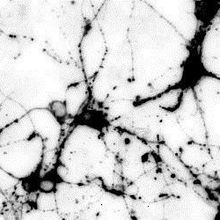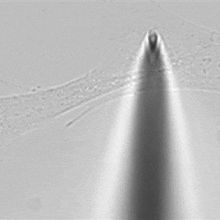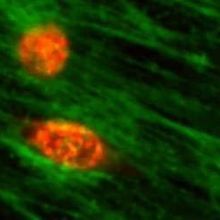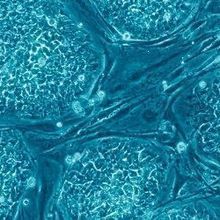fibroblasts

Stem Cells Could Save the Giant Panda
Sahana Sitaraman, PhD | Sep 20, 2024 | 4 min read
Scientists have perfected the recipe to convert giant panda skin cells into stem cells to study the animal’s biology and aid its conservation.

Glycogen Metabolism May Play a Key Role in Pulmonary Fibrosis
Charlene Lancaster, PhD | Sep 11, 2023 | 4 min read
Researchers discover that glycogen and N-linked glycans accumulate in fibrotic regions of the lung and may be important for therapy development.

Immunotherapy Treats Fibrosis in Mice
Alejandra Manjarrez, PhD | Sep 15, 2022 | 4 min read
Researchers report that vaccination against proteins found on profibrotic cells reduced liver and lung fibrosis in laboratory rodents.

Missing Y Chromosome in Mouse Blood Causes Heart Dysfunction
Patience Asanga | Jul 16, 2022 | 3 min read
An analysis of human data from the UK biobank also finds an association between Y chromosome loss and heart disease in men.

Robot Finger’s Living Skin Stretches, Heals Like the Real Thing
Christie Wilcox, PhD | Jun 10, 2022 | 2 min read
Researchers in Japan have given a plastic robot finger a layered coating made from actual, living skin cells. Next, they aim to add hair and sweat glands.

Skin Cells Can Transform To Help Fight Acne
Dan Robitzski | Mar 2, 2022 | 5 min read
A new study reveals that the fibroblasts in tissue surrounding acne infections play an active role in the body’s immune response—and that existing treatments help trigger them to do so.

Breast Cancer Cells Churn Out Cholesterol to Fuel Metastasis
Alejandra Manjarrez, PhD | Feb 4, 2022 | 4 min read
A study uncovers a novel connection between the biomolecule and cancer progression.

CAR T Cells Mend Broken Mouse Hearts
Sophie Fessl, PhD | Jan 6, 2022 | 4 min read
Specialized immune cells generated in vivo reduce cardiac scar tissue in mice, a new study shows.

Understanding Immune-Mediated Damage After Respiratory Infection
The Scientist Creative Services Team in collaboration with 10x Genomics | Feb 17, 2021 | 1 min read
Paul Thomas from St. Jude Children’s Research Hospital will discuss how he used single cell and spatial transcriptomics to discover the underlying mechanism of an inflammatory immune response in the lungs.

Identified: Molecular Predictors of Rheumatoid Arthritis Relapse
Ruth Williams | Jul 15, 2020 | 4 min read
The presence of a particular set of RNAs in the blood forewarns of an onset of severe symptoms and points to the cells involved.

CAR T Immunotherapy May Find New Use in Treating Cardiac Fibrosis
Emma Yasinski | Sep 11, 2019 | 3 min read
Scientists show the approach can kill cells that cause hardening of heart tissue in mice.

Image of the Day: Scarred Hearts
Ashley Yeager | Dec 4, 2018 | 1 min read
Maps of diving cells before and after heart attacks in mice offer additional evidence against the existence of cardiac stem cells.

Image of the Day: Cooking Up Neurons
The Scientist and The Scientist Staff | May 11, 2018 | 1 min read
Using different combinations of transcription factors, researchers create a diverse array of neurons from mouse skin cells.

Image of the Day: 3-D Nanofibers
The Scientist and The Scientist Staff | Mar 7, 2018 | 1 min read
Researchers created a nanofibrous scaffold to see how it supports cell growth.

Image of the Day: Itty Bitty Cell Sucker
The Scientist | Jul 21, 2017 | 1 min read
With a diameter smaller than 100 nanometers, this nanopipette’s indiscernible tip is tiny enough to suck up minute contents of a single cell.

With CRISPR, Scientists Make Neurons From Fibroblasts
Kerry Grens | Aug 15, 2016 | 1 min read
Researchers use the CRISPR/Cas system to express three transcription-factor genes, changing the identities of mouse cells.

Watching Cancer on the Move
Jef Akst | Dec 15, 2015 | 1 min read
Fibroblasts help tumors metastasize by paving a “migration highway” through the extracellular matrix, scientists report.

Highly Cited Stem Cell Paper Pulled
Kerry Grens | Aug 5, 2014 | 1 min read
The authors of a 2008 Nature paper have retracted it after new data watered down the conclusions.

Week in Review: February 24–28
Tracy Vence | Feb 28, 2014 | 3 min read
New PLOS data sharing rules; mouse cortical connectome published; reprogramming astrocytes into neurons and fibroblasts into hepatocytes
